JAVA基础----String类型的简单介绍
文章目录
1. String类的重要性
C语言中已经涉及到字符串了,但是在C语言中要表示字符串只能使用字符数组或者字符指针,可以使用标准库提供的字符串系列函数完成大部分操作,但是这种将数据和操作数据方法分离开的方式不符合面相对象的思想,而字符串应用又非常广泛,因此Java语言专门提供了String类。
2. 常用方法
2.1 字符串构造
String类提供的构造方式非常多,常用的就以下三种:
// 使用常量串构造
String s1 = "hello bit";
System.out.println(s1);
// 直接newString对象
String s2 = new String("hello bit");
System.out.println(s1);
// 使用字符数组进行构造
char[] array = {'h','e','l','l','o','b','i','t'};
String s3 = new String(array);
System.out.println(s1);
【注意】
- String是引用类型,内部并不存储字符串本身,在String类的实现源码中,String类实例变量如下:

public static void main(String[] args) {
// s1和s2引用的是不同对象 s1和s3引用的是同一对象
String s1 = new String("hello");
String s2 = new String("world");
String s3 = s1;
System.out.println(s1.length()); // 获取字符串长度---输出5
System.out.println(s1.isEmpty()); // 如果字符串长度为0,返回true,否则返回false
}
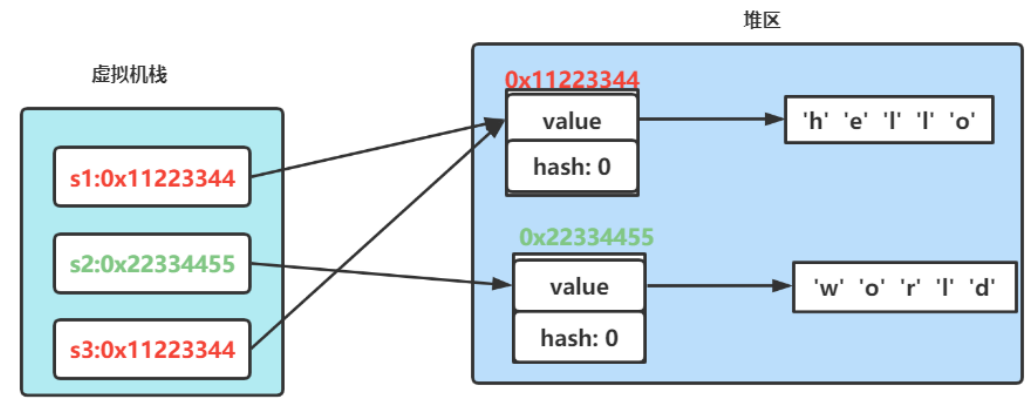
2. 在Java中“”引起来的也是String类型对象。
// 打印"hello"字符串(String对象)的长度
System.out.println("hello".length());
2.2 String对象的比较
字符串的比较是常见操作之一,比如:字符串排序。Java中总共提供了4中方式:
1. == 比较是否引用同一个对象
注意:对于内置类型 ==, 比较的是变量中的值;对于引用类型 == 比较的是引用中的地址。
int a = 10; int b = 20; int c = 10; // 对于基本类型变量,==比较两个变量中存储的值是否相同 System.out.println(a == b); // false System.out.println(a == c); // true // 对于引用类型变量,==比较两个引用变量引用的是否为同一个对象 String s1 = new String("hello"); String s2 = new String("hello"); String s3 = new String("world"); String s4 = s1; System.out.println(s1 == s2); // false System.out.println(s2 == s3); // false System.out.println(s1 == s4); // true2. boolean equals(Object anObject) 方法:按照字典序比较
字典序:字符大小的顺序
String类重写了父类Object中equals方法,Object中equals默认按照==比较,String重写equals方法后,按照如下规则进行比较,比如: s1.equals(s2)
public static void main(String[] args) { String s1 = new String("hello"); String s2 = new String("hello"); String s3 = new String("Hello"); // s1、s2、s3引用的是三个不同对象,因此==比较结果全部为false System.out.println(s1 == s2); // false System.out.println(s1 == s3); // false // equals比较:String对象中的逐个字符 // 虽然s1与s2引用的不是同一个对象,但是两个对象中放置的内容相同,因此输出true // s1与s3引用的不是同一个对象,而且两个对象中内容也不同,因此输出false System.out.println(s1.equals(s2)); // true System.out.println(s1.equals(s3)); // false }3. int compareTo(String s) 方法: 按照字典序进行比较
与equals不同的是,equals返回的是boolean类型,而compareTo返回的是int类型。具体比较方式:
1. 先按照字典次序大小比较,如果出现不等的字符,直接返回这两个字符的大小差值
2. 如果前k个字符相等(k为两个字符长度最小值),返回值两个字符串长度差值public static void main(String[] args) { String s1 = new String("abc"); String s2 = new String("ac"); String s3 = new String("abc"); String s4 = new String("abcdef"); System.out.println(s1.compareTo(s2)); // 不同输出字符差值-1 System.out.println(s1.compareTo(s3)); // 相同输出 0 System.out.println(s1.compareTo(s4)); // 前k个字符完全相同,输出长度差值 -3 }4. int compareToIgnoreCase(String str) 方法:与compareTo方式相同,但是忽略大小写比较
public static void main(String[] args) { String s1 = new String("abc"); String s2 = new String("ac"); String s3 = new String("ABc"); String s4 = new String("abcdef"); System.out.println(s1.compareToIgnoreCase(s2)); // 不同输出字符差值-1 System.out.println(s1.compareToIgnoreCase(s3)); // 相同输出 0 System.out.println(s1.compareToIgnoreCase(s4)); // 前k个字符完全相同,输出长度差值 -3 } >```
2.3 字符串查找
字符串查找也是字符串中非常常见的操作,String类提供的常用查找的方法:
| 方法 | 功能 |
|---|---|
| char charAt(int index) | 返回index位置上字符,如果index为负数或者越界,抛出IndexOutOfBoundsException异常 |
| int indexOf(int ch) | 返回ch第一次出现的位置,没有返回-1 |
| int indexOf(int ch, int fromIndex) | 从fromIndex位置开始找ch第一次出现的位置,没有返回-1 |
| int indexOf(String str) | 返回str第一次出现的位置,没有返回-1 |
| int indexOf(String str, int fromIndex) | 从fromIndex位置开始找str第一次出现的位置,没有返回-1 |
| int lastIndexOf(int ch) | 从后往前找,返回ch第一次出现的位置,没有返回-1 |
| int lastIndexOf(int ch, int fromIndex) | 从fromIndex位置开始找,从后往前找ch第一次出现的位置,没有返回-1 |
| int lastIndexOf(String str) | 从后往前找,返回str第一次出现的位置,没有返回-1 |
| int lastIndexOf(String str, int fromIndex) | 从fromIndex位置开始找,从后往前找str第一次出现的位置,没有返回-1 |
String s = "aaabbbcccaaabbbccc";
System.out.println(s.charAt(3)); // 'b'
System.out.println(s.indexOf('c')); // 6
System.out.println(s.indexOf('c', 10)); // 15
System.out.println(s.indexOf("bbb")); // 3
System.out.println(s.indexOf("bbb", 10)); // 12
System.out.println(s.lastIndexOf('c')); // 17
System.out.println(s.lastIndexOf('c', 10)); // 8
System.out.println(s.lastIndexOf("bbb")); // 12
System.out.println(s.lastIndexOf("bbb", 10)); // 3
注意:上述方法都是实例方法。
2.4 转化
- 数值和字符串转化
public static void main(String[] args) {
// 数字转字符串
String s1 = String.valueOf(1234);
String s2 = String.valueOf(12.34);
String s3 = String.valueOf(true);
String s4 = String.valueOf(new Student("Hanmeimei", 18));
System.out.println(s1);
System.out.println(s2);
System.out.println(s3);
System.out.println(s4);
System.out.println("=================================");
// 字符串转数字
// 注意:Integer、Double等是Java中的包装类型
int data1 = Integer.parseInt("1234");
double data2 = Double.parseDouble("12.34");
System.out.println(data1);
System.out.println(data2); }
- 大小写转换
public static void main(String[] args) {
String s1 = "hello";
String s2 = "HELLO";
// 小写转大写
System.out.println(s1.toUpperCase());
// 大写转小写
System.out.println(s2.toLowerCase());
}
- 字符串转数组
public static void main(String[] args) {
String s = "hello";
// 字符串转数组
char[] ch = s.toCharArray();
for (int i = 0; i < ch.length; i++) {
System.out.print(ch[i]);
}
System.out.println();
// 数组转字符串
String s2 = new String(ch);
System.out.println(s2);
}
- 格式化
public static void main(String[] args) {
String s = String.format("%d-%d-%d", 2019, 9,14);
System.out.println(s);
}
2.5 字符串替换
使用一个指定的新的字符串替换掉已有的字符串数据,可用的方法如下:
| 方法 | 功能 |
|---|---|
| String replaceAll(String regex, String replacement) | 替换所有的指定内容 |
| String replaceFirst(String regex, String replacement) | 替换首个内容 |
代码示例: 字符串的替换处理
String str = "helloworld" ;
System.out.println(str.replaceAll("l", "_"));
System.out.println(str.replaceFirst("l", "_"));
运行结果:
he__owor_d
he_loworld
注意事项: 由于字符串是不可变对象, 替换不修改当前字符串, 而是产生一个新的字符串.
2.6 字符串拆分
可以将一个完整的字符串按照指定的分隔符划分为若干个子字符串。
可用方法如下:
| 方法 | 功能 |
|---|---|
| String[] split(String regex) | 将字符串全部拆分 |
| String[] split(String regex, int limit) | 将字符串以指定的格式,拆分为limit组 |
代码示例: 实现字符串的拆分处理
String str = "hello world abc" ;
String[] result = str.split(" ") ; // 按照空格拆分
for(String s: result) {
System.out.println(s);
}
运行结果:
hello
world
abc
代码示例: 字符串的部分拆分
String str = "hello world hello bit" ;
String[] result = str.split(" ",2) ;
for(String s: result) {
System.out.println(s);
}
运行结果:
hello
world abc
拆分是特别常用的操作. 一定要重点掌握. 另外有些特殊字符作为分割符可能无法正确切分, 需要加上转义.
代码示例: 拆分IP地址
String str = "192.168.1.1" ;
String[] result = str.split("\\.") ;
for(String s: result) {
System.out.println(s);
}
String str3 = "192\\168\\1\\1";
String[] strings2 = str3.split("\\\\");// \转义字符串
for (int i = 0; i < strings2.length; i++) {
System.out.println(strings2[i]);
}
注意事项:
1. 字符".“,”|“,”*“,”+“都得加上转义字符,前面加上 “\\” .
2. 而如果是 “\\” ,那么就得写成 “\\\\” .
3. 如果一个字符串中有多个分隔符,可以用”|"作为连字符.
代码示例: 多次拆分
String string = "name=zhangsanfeng&age=12";
String[] ret = string.split("=|&");
for (int i = 0; i < ret.length; i++) {
System.out.println(ret[i]);
}
String[] ret2 = string.split("=");
for (int i = 0; i < ret2.length; i++) {
String s = ret2[i];
String[] ret3 = s.split("&");
for (int j = 0; j < ret3.length; j++) {
System.out.println(ret3[j]);
}
}
}
运行结果:
zhangsanfeng
age
12
name
zhangsanfeng
age
12
2.7 字符串截取
从一个完整的字符串之中截取出部分内容。可用方法如下:
| 方法 | 功能 |
|---|---|
| String substring(int beginIndex) | 从指定索引截取到结尾 |
| String substring(int beginIndex, int endIndex) | 截取部分内容 |
代码示例: 观察字符串截取
String str = "helloworld" ;
System.out.println(str.substring(5));//w
System.out.println(str.substring(0, 5));//hello
注意事项:
1. 索引从0开始
2. 注意前闭后开区间的写法, substring(0, 5) 表示包含 0 号下标的字符, 不包含 5 号下标
2.8 其他操作方法
| 方法 | 功能 |
|---|---|
| String trim() | 去掉字符串中的左右空格,保留中间空格 |
| String toUpperCase() | 字符串转大写 |
| String toLowerCase() | 字符串转小写 |
代码示例: 观察trim()方法的使用
String str = " hello world " ; //只会去除两边的,不会去除中间的空格
System.out.println("["+str+"]");
System.out.println("["+str.trim()+"]");
运行结果:
[ hello world ]
[hello world]
trim 会去掉字符串开头和结尾的空白字符(空格, 换行, 制表符等).
代码示例: 大小写转换
String str = " hello%$$%@#$%world 哈哈哈 " ;
System.out.println(str.toUpperCase());//只转换字母
System.out.println(str.toLowerCase());//只转换字母
运行结果:
HELLO%$$%@#$%WORLD 哈哈哈
hello%$$%@#$%world 哈哈哈
2.9 字符串的不可变性
String是一种不可变对象. 字符串中的内容是不可改变。字符串不可被修改,是因为:
- String类在设计时就是不可改变的,String类实现描述中已经说明了
以下来自JDK1.8中String类的部分实现:
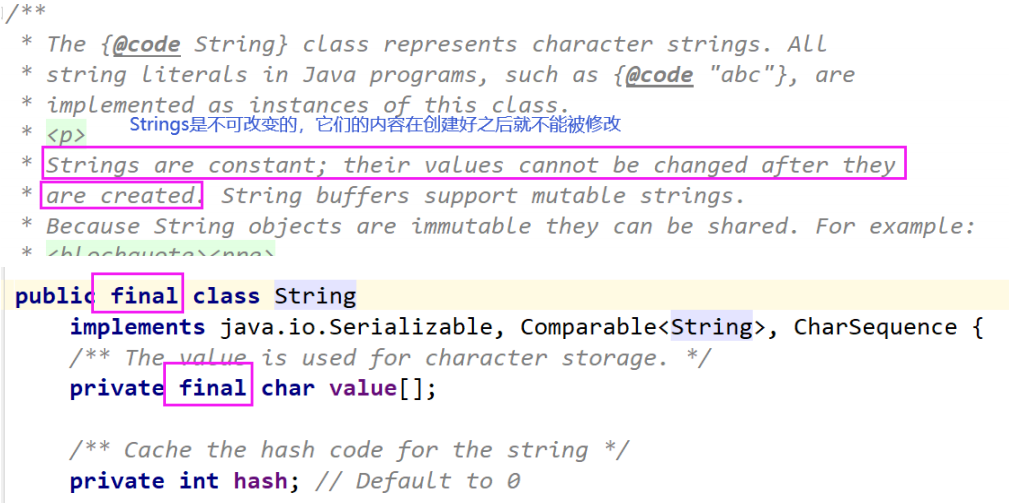
字符串不可被修改,是因为value的值是被private限定修饰符所修饰的,无法获取value的内容,对value进行修改,所以字符串是不可变的。
String类中的字符实际保存在内部维护的value字符数组中,该图中的两个final表示:
- String类被final修饰,表明该类不能被继承
- value被修饰被final修饰,表明value自身的值不能改变,即不能引用其它字符数组,但是其引用空间中的内容可以修改。
误区:
网上有些人说:字符串不可变是因为其内部保存字符的数组被final修饰了,因此不能改变。这种说法是错误的,不是因为String类自身,或者其内部value被final修饰而不能被修改。
final修饰类表明该类不想被继承,final修饰引用类型表明该引用变量不能引用其他对象,但是其引用对象中的内容是可以修改的。
public static void main(String[] args) {
final int array[] = {1,2,3,4,5};
array[0] = 100; //其引用对象中的内容是可以修改的
System.out.println(Arrays.toString(array));
// array = new int[]{4,5,6}; //该引用变量不能引用其他对象
// 编译报错:Error:(19, 9) java: 无法为最终变量array分配值
}
- 所有涉及到可能修改字符串内容的操作都是创建一个新对象,改变的是新对象
比如 replace 方法: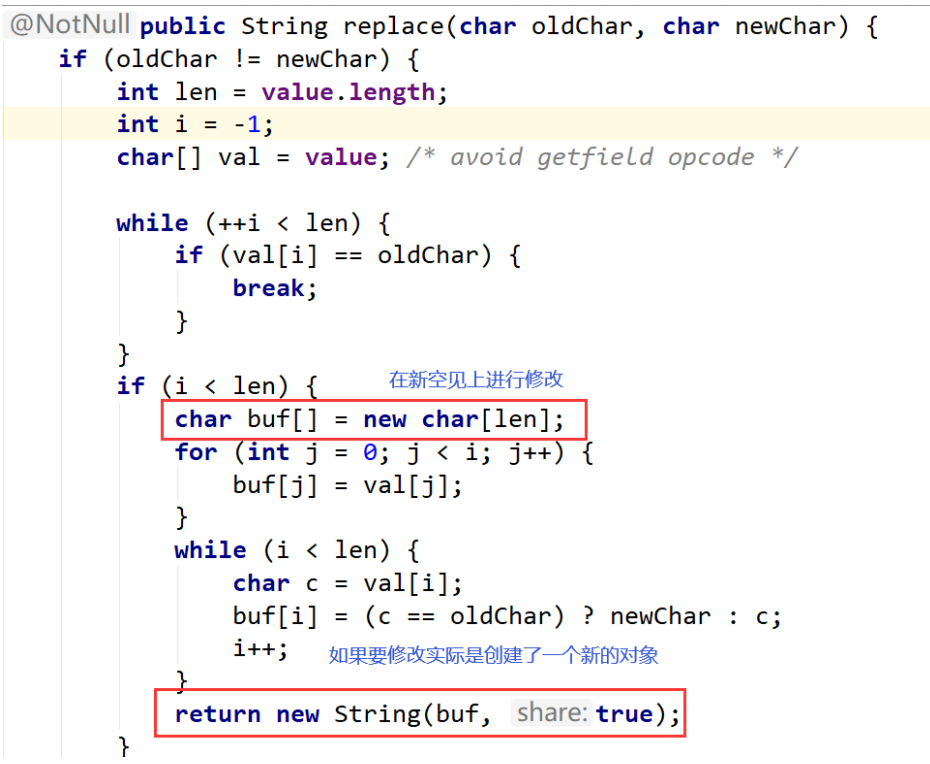
2.10 字符串修改
注意:尽量避免直接对String类型对象进行修改,因为String类是不能修改的,所有的修改都会创建新对象,效率非常低下。
public static void main(String[] args) {
String s = "hello";
s += " world";
System.out.println(s); // 输出:hello world
}
但是这种方式不推荐使用,因为其效率非常低,中间创建了好多临时对象。使用反编译查看:

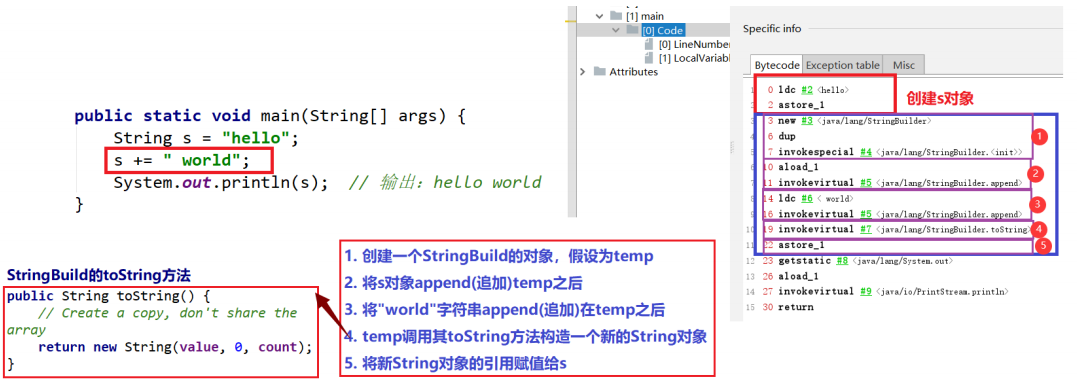
上述代码等价于下面的代码:
public static void main(String[] args) {
String s = "hello";
StringBuilder temp = new StringBuilder();
temp.append(s);
temp.append(" world");
s = temp.toString();
System.out.println(s);
}
我们发现在对String修改过程中,创建了额外的新的对象。
2.11 借助StringBuffer 和 StringBuilder 观察String进行修改的效率
public static void main(String[] args) {
long start = System.currentTimeMillis();
String s = "";
for (int i = 0; i < 10000; ++i) {
s += i;
}
long end = System.currentTimeMillis();
System.out.println("String:"+ (end - start));
start = System.currentTimeMillis();
StringBuffer sbf = new StringBuffer("");
for (int i = 0; i < 10000; ++i) {
sbf.append(i);
}
end = System.currentTimeMillis();
System.out.println("StringBuffer:"+ (end - start));
start = System.currentTimeMillis();
StringBuilder sbd = new StringBuilder();
for (int i = 0; i < 10000; ++i) {
sbd.append(i);
}
end = System.currentTimeMillis();
System.out.println("StringBuilder:"+ (end - start));
}
运行结果:
String:293
StringBuffer:1
StringBuilder:1
对代码进行反编译:
String部分的代码:

StringBuilder和StringBuffer部分的代码:
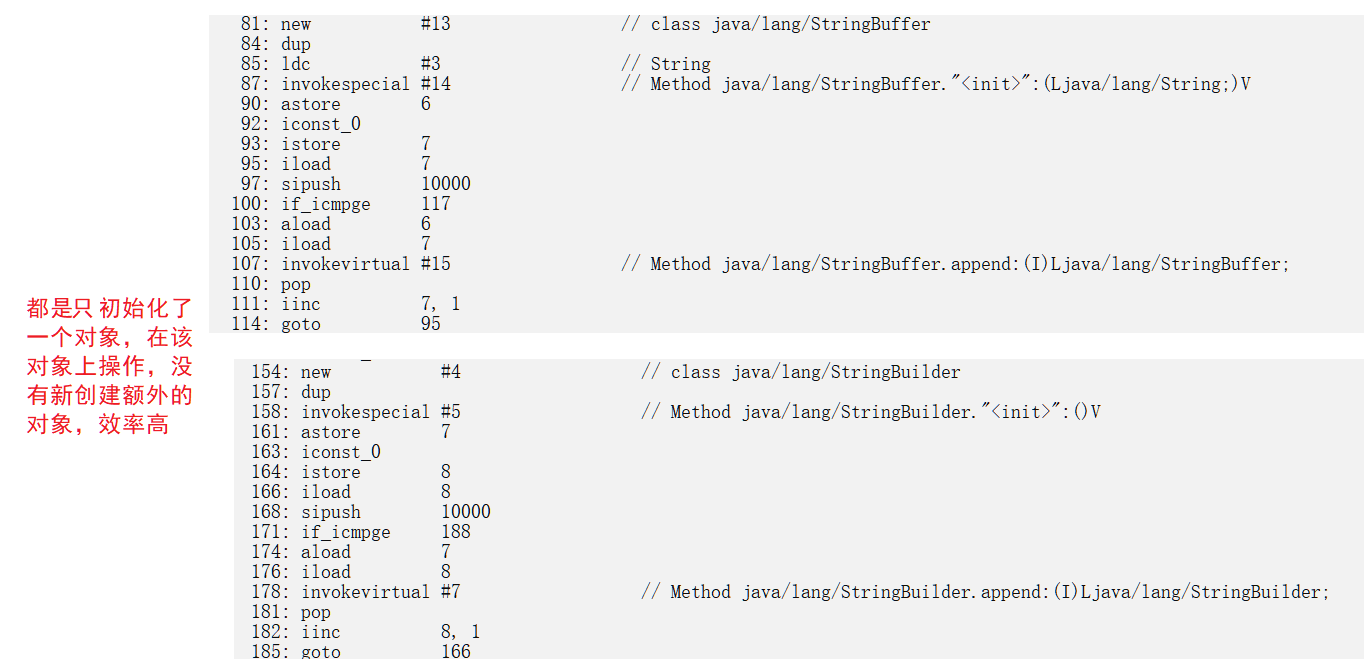
综上所述,可以看到在对String类进行修改时,效率是非常慢的,因此:尽量避免对String的直接需要,如果要修改建议尽量使用StringBuffer或者StringBuilder。
3. StringBuilder和StringBuffer
3.1 StringBuilder的介绍
由于String的不可更改特性,为了方便字符串的修改,Java中又提供StringBuilder和StringBuffer类。
这两个类大部分功能是相同的,不同点是StringBuffer采用同步处理,属于线程安全操作;而StringBuilder未采用同步处理,属于线程不安全操作,这里介绍 StringBuilder常用的一些方法,其它需要用到了大家可参阅 StringBuilder在线文档
| 方法 | 说明 |
|---|---|
| StringBuff append(String str) | 在尾部追加,相当于String的+=,可以追加:boolean、char、char[]、double、float、int、long、Object、String、StringBuff的变量 |
| char charAt(int index) | 获取index位置的字符 |
| int length() | 获取字符串的长度 |
| int capacity() | 获取底层保存字符串空间总的大小 |
| void ensureCapacity(int mininmumCapacity) | 扩容 |
| void setCharAt(int index, char ch) | 将index位置的字符设置为ch |
| int indexOf(String str) | 返回str第一次出现的位置 |
| int indexOf(String str, int fromIndex) | 从fromIndex位置开始查找str第一次出现的位置 |
| int lastIndexOf(String str) | 返回最后一次出现str的位置 |
| int lastIndexOf(String str, int fromIndex) | 从fromIndex位置开始找str最后一次出现的位置 |
| StringBuff insert(int offset, String str) | 在offset位置插入:八种基类类型 & String类型 & Object类型数据 |
| StringBuffer deleteCharAt(int index) | 删除index位置字符 |
| StringBuffer delete(int start, int end) | 删除[start, end)区间内的字符 |
| StringBuffer replace(int start, int end, String str) | 将[start, end)位置的字符替换为str |
| String substring(int start) | 从start开始一直到末尾的字符以String的方式返回 |
| String substring(int start,int end) | 将[start, end)范围内的字符以String的方式返回 |
| StringBuffer reverse() | 反转字符串 |
| String toString() | 将所有字符按照String的方式返回 |
public static void main(String[] args) {
StringBuilder sb1 = new StringBuilder("hello");
StringBuilder sb2 = sb1;
// 追加:即尾插-->字符、字符串、整形数字
sb1.append(' '); // hello
sb1.append("world"); // hello world
sb1.append(123); // hello world123
System.out.println(sb1); // hello world123
System.out.println(sb1 == sb2); // true
System.out.println(sb1.charAt(0)); // 获取0号位上的字符 h
System.out.println(sb1.length()); // 获取字符串的有效长度14
System.out.println(sb1.capacity()); // 获取底层数组的总大小
sb1.setCharAt(0, 'H'); // 设置任意位置的字符 Hello world123
sb1.insert(0, "Hello world!!!"); // Hello world!!!Hello world123
System.out.println(sb1);
System.out.println(sb1.indexOf("Hello")); // 获取Hello第一次出现的位置
System.out.println(sb1.lastIndexOf("hello")); // 获取hello最后一次出现的位置
sb1.deleteCharAt(0); // 删除首字符
sb1.delete(0,5); // 删除[0, 5)范围内的字符
String str = sb1.substring(0, 5); // 截取[0, 5)区间中的字符以String的方式返回
System.out.println(str);
sb1.reverse(); // 字符串逆转
str = sb1.toString(); // 将StringBuffer以String的方式返回
System.out.println(str);
}
从上述例子可以看出:String和StringBuilder最大的区别在于String的内容无法修改,而StringBuilder的内容可以修改。频繁修改字符串的情况考虑使用StringBuilder。
注意:String和StringBuilder类不能直接转换。如果要想互相转换,可以采用如下原则:
- String变为StringBuilder: 利用StringBuilder的构造方法或append()方法
- StringBuilder变为String: 调用toString()方法。
3.2 String、StringBuffer、StringBuilder的区别
- String的内容不可修改,StringBuffer与StringBuilder的内容可以修改.
- StringBuffer与StringBuilder大部分功能是相似的
- StringBuffer采用同步处理,属于线程安全操作;而StringBuilder未采用同步处理,属于线程不安全操作
| String | StringBuffer | StringBuilder | |
|---|---|---|---|
| 执行速度 | 最差 | 其次 | 最高 |
| 线程安全 | 线程安全 | 线程安全 | 线程不安全 |
| 使用场景 | 少量字符串操作 | 多线程环境下的大量操作 | 单线程环境下的大量操作 |
【总结】
- 不可变性:
String 对象一旦被创建后,就不能再进行修改,只能通过创建新的String对象来实现字符串内容的更新。这种设计可能会导致不必要的内存消耗和性能损失,尤其是在字符串修改频繁的情况下。- 线程安全性:
StringBuilder 不是线程安全的类,这意味着在同一时间多个线程尝试修改同一个StringBuilder
时,可能发生数据不一致的情况。 StringBuffer 是一种线程安全的类,它通过使用 synchronized
关键字和其他机制来确保在同一时刻只有一个线程能够访问字符串缓冲区,从而提供线程安全的环境。- 性能:
StringBuilder 不需要进行加锁操作,因此在字符串拼接或修改操作较为繁重的情况下,性能通常优于String类型。 StringBuffer 虽然具有更好的线程安全性,但在执行这些操作时会有额外的开销,因此其性能可能会低于StringBuilder。综上所述,如果你需要在单线程环境中进行大量的字符串拼接或修改,或者关心性能优化,那么选择
StringBuilder将更合适。而在多线程环境中,特别是需要确保线程安全的情况下,你应该选择StringBuffer。
本文来自互联网用户投稿,该文观点仅代表作者本人,不代表本站立场。本站仅提供信息存储空间服务,不拥有所有权,不承担相关法律责任。 如若内容造成侵权/违法违规/事实不符,请联系我的编程经验分享网邮箱:chenni525@qq.com进行投诉反馈,一经查实,立即删除!
- Python教程
- 深入理解 MySQL 中的 HAVING 关键字和聚合函数
- Qt之QChar编码(1)
- MyBatis入门基础篇
- 用Python脚本实现FFmpeg批量转换
- 普兰资产(PLAN B KRYPTO ASSETS):Schutz AI 公链引领数字资产新时代
- Java自定义注解:优雅的代码标记
- DataFunSummit:2023年OLAP引擎架构峰会:核心内容与学习收获(附大会核心PPT下载)
- C#中ArrayList运行机制及其涉及的装箱拆箱
- 字符串算法总结|双指针的总结
- NineAi 新版AI系统网站源码 ChatGPT
- Javaweb考前复习冲刺(不断更新版)
- 3D Web可视化开发工具包HOOPS Communicator:提供Web端浏览大型模型新方案!
- 七招教你如何做好微信小程序优化推广
- 【驱动序列】简单聊聊开发驱动程序的缘由和驱动程序基本信息